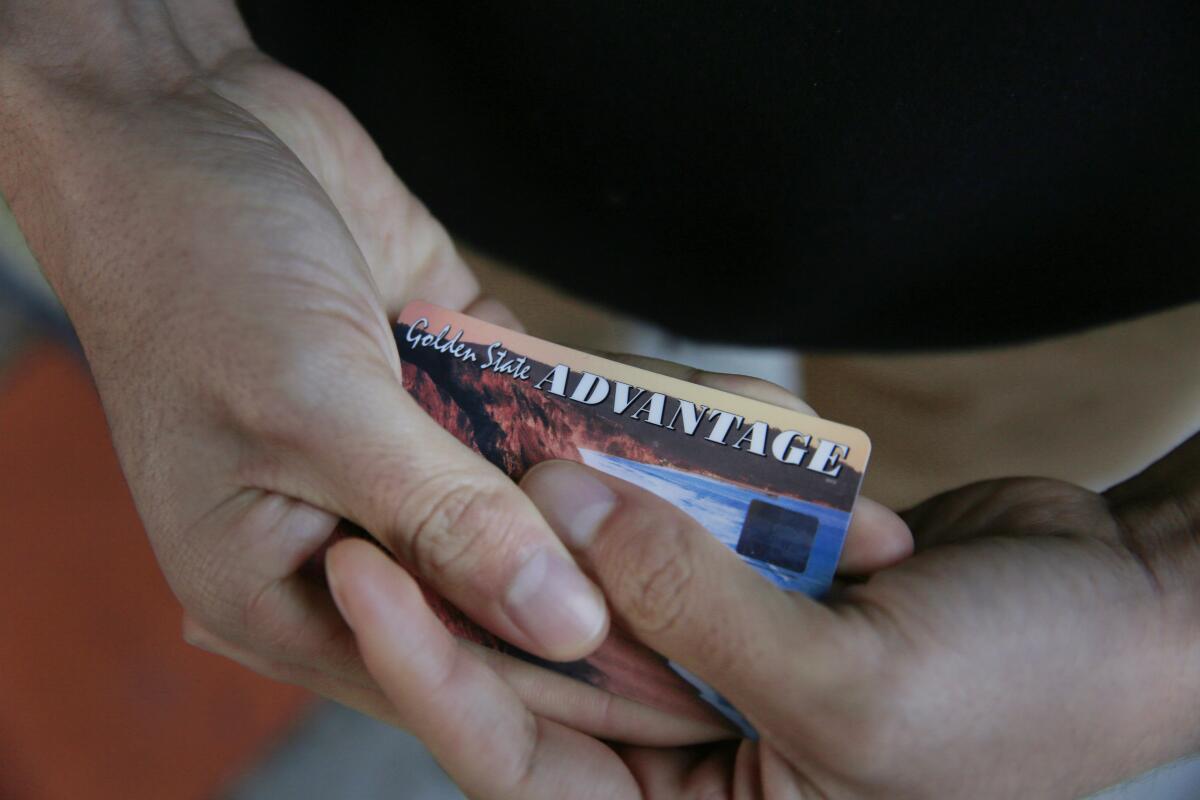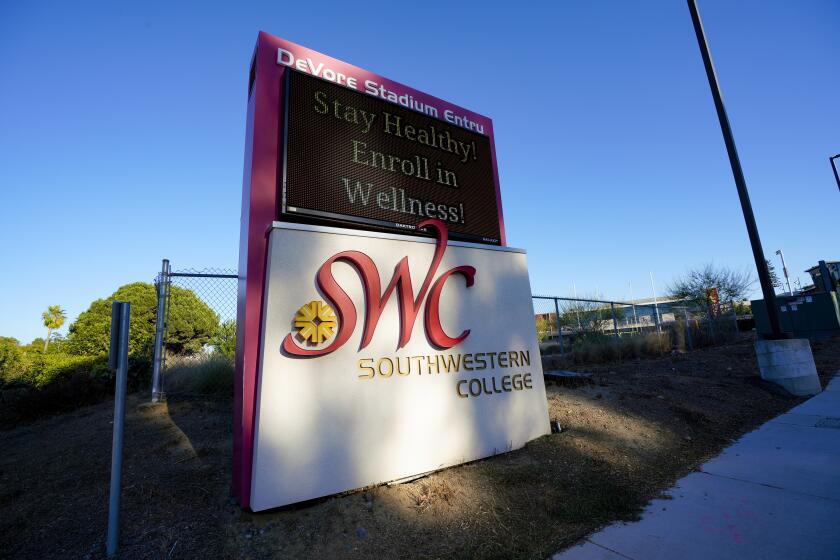Struck by EBT fraud, thousands of San Diego food-stamp and welfare recipients struggle to find food, pay bills

- Share via
The challenge of feeding her children has never been simple for Brittany Moats, a single mother of three from La Mesa.
Things got easier a couple of years ago, when Moats qualified for almost $750 a month in food stamps from the county Health and Human Services Agency. But when she bought a pizza last month, she noticed the balance on her account was close to zero.
Get our essential investigative journalism
Sign up for the weekly Watchdog newsletter for investigations, data journalism and more.
You may occasionally receive promotional content from the Los Angeles Times.
“I hurried up and called the number on my card and was listening to all the transactions, but I didn’t do them,” she said. “I filed a dispute and eventually got refunded, but then it happened again this month.”
Moats is one of thousands of people in San Diego County who have seen their electronic benefit cards hacked since September.
The crime wave of nearly 5,000 hacks into EBT accounts — electronic benefit transfers — has left thousands of victims struggling to find food and others unable to pay rent or other bills.
County officials said they are aware of the problem and working with families to restore their benefits. They are also helping local, state and federal law enforcement agencies investigate.
“This is being conducted by a sophisticated crime ring,” said Michael Workman, a San Diego County spokesperson. “This crime activity is most frequent at the beginning of the month, after public assistance benefits are loaded to the EBT cards.”
County health officials said they first began receiving reports of missing funds late last summer.
The real cost of child care
California’s child care aid reaches only a small fraction of the families who need it, and it’s stretching providers to the limit. Education reporter Kristen Taketa examines how the system is falling short, and who pays the price.
Clients in the CalFresh and CalWorks programs administered by the Health and Human Services Agency began alerting caseworkers days after funds were electronically added to their debit cards.
CalFresh is the state‘s food stamp program, known nationally as SNAP, for Supplemental Nutrition Assistance Program. The CalWorks program provides cash relief and other services to families with children.
In most of the thefts, county workers responded by requesting a client disclosure attesting that specific charges were not incurred, then closing out the accounts and issuing new cards.
But that process can take days, and clients say they struggled to pay for groceries and other expenses during the time it took to process the reports and award new benefits.
Feeding San Diego was recently awarded a $50,000 grant to fund its federal meal program outreach
“We just have to borrow food from my mom,” Moats said. “If it goes on much longer, what are we going to do? How are we going to eat? We depend on this.”
County officials say the organized hacks are not limited to San Diego. Workman said public agencies up and down the state have reported similar thefts in recent months. Social workers are doing their best to speed up processing of new EBT cards, he said.
“This issue has nothing at all to do with the recipients of the public assistance benefits,” Workman said. “We have been regularly communicating with our customers about this issue.”
The San Diego FBI field office said the thefts are a state matter and referred law enforcement questions to the state social services agency.
The California Department of Social Services, which distributes food stamps, said it has been working to control the thefts and also to improve the systems it relies on to deliver benefits.
“This past June, Card Verification Value functionality for all EBT cards was recently enabled, which added an additional layer of security to help mitigate EBT theft,” Social Services spokesperson Jason Montiel said in a statement.
The state agency also recently received a $740,000 grant to study ways to reduce fraud, and Gov. Gavin Newsom just included $50 million for EBT theft prevention in his new budget, Montiel said.
The state is supposed to help families afford child care. But few qualify for help, and most of those who do are not being served.
According to state data, California counties reimbursed CalWorks beneficiaries almost $30 million between July 2021 and September 2022 — including $4 million last September alone.
Counties returned almost $5 million to food stamp recipients over the same 15-month period, with more than $2 million rebated in August and September of last year.
Montiel said the thefts amount to less than 1% of the $3.2 billion in CalWorks allotments and just 0.04% of $11.2 billion in food assistance over the 15 months.
Multiple criminal probes also are underway. “Once investigations have been completed, additional details will be available,” Montiel said.
Victims say when they report the hacks, the phone lines are often clogged with calls, and in-person reports at the county Family Resource Centers can take hours.
Where should you look for child care? What does it cost? How can you get help paying for it? There’s aid available, but the system can be tough to navigate. Here’s what you need to know.
Another food stamp beneficiary, who asked not to be identified for fear of losing her benefits for speaking out, said her monthly allowance was drained within hours of being loaded onto her card.
“I went to go shopping, and my card got declined,” said the woman, who lives near Lemon Grove. “They spent the whole $281.”
At the Family Resource Center in El Cajon, where social workers process applications for food stamps and other public assistance, the victimized woman said she was told it would take days or longer to reinstate her benefits.
“I said, ‘How are you supposed to eat until then?’” she said. “They said I have to go to a food bank.”

Food stamps are awarded under the federal Supplemental Nutrition Assistance Program and are distributed in California by individual counties under the Department of Social Services.
Once qualified, beneficiaries are awarded a card that resembles a typical debit card, although they are not affiliated with banks or credit unions.
That’s an important distinction, because private financial institutions have improved security in their electronic payment systems by adding microchips to millions of credit and debit cards across the nation and world.
Shelly Dieu, manager of the San Diego Hunger Coalition, said her organization has seen a notable increase in fraud claims in recent months.
She said the nonprofit urges clients to track their balances and check their online accounts as often as possible, because resolving the problem and reclaiming the benefits can be difficult and time-consuming.
“It’s difficult to know when benefits are stolen because not everyone goes to the grocery store all the time, and not everyone is checking so intently,” Dieu said.
Once robbed, “the processing time can take 10 days,” Dieu said. “Right now, the county has been quite inundated, so it’s taking a little longer than that.”
Come fall, students will be able to use their benefits at on-campus food services, cafes
Advocacy groups like the Western Center on Law and Poverty are pressing policymakers to upgrade EBT cards.
“Updating the card technology is critical to protecting recipients who we know are going hungry and need assistance in meeting their basic needs,” said Christopher Sanchez, a policy director at the center.
“There absolutely needs to be a minimum standard that ensures these protections while ensuring that clients are able to use these benefits without interruption,” he said.
San Diego County has struggled for years to provide food stamp benefits to eligible residents.
The San Diego Union-Tribune reported in 2006 that the region enrolled barely 25% of people who qualify for the help — at the time the lowest enrollment of any large city in America.
Under pressure from social service providers and others, the Board of Supervisors directed public health officials to do a better job promoting the program and relax some of the local policies that had contributed to the low enrollment.
The marketing and application changes have boosted the number of people in San Diego now receiving CalFresh benefits.
According to the state Department of Social Services, some 388,000 people in San Diego County were receiving monthly benefits as of November — almost 1 in every 8 residents.
Out of almost 18,000 applications received that month, however, just over 10,000 were approved.
More to Read
Sign up for Essential California
The most important California stories and recommendations in your inbox every morning.
You may occasionally receive promotional content from the Los Angeles Times.


















